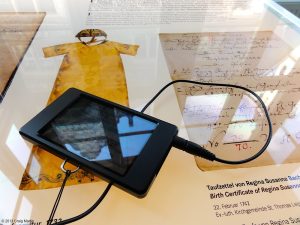Bach museum, Leipzig
In Germany, museums dedicated to famous composers seem to be ubiquitous — we’ve visited three in the last month or so. Of the three, by far the best was the Bach Museum in Leipzig.
Johann Sebastian Bach wasn’t born in Leipzig, but he did spend 27 years of his life there, and composed around 500 works during his stay in the city — so a museum devoted to him is highly justified. It’s located in the city centre, opposite the church where Bach’s body has been interred since 1950; between the two, a larger-than-lifesize statue of the maestro graces a large square — Leipzig is REALLY proud of Bach.
The museum costs €8 to enter and audio guides are freely available; you just have to leave an ID card as a deposit. These guides are excellent: well performed, with interesting information divided into several tracks per room — and quite a few of the tracks include recordings of Bach’s music. The exhibits are interesting and several are hands-on, such as the organ pipes that play music when you touch them, or the virtual orchestra room with pictures of instruments of Bach’s time hanging on the walls; a light behind each picture lights up when the corresponding instrument is playing, and you can press a button to amplify its sound.

We stopped into a temporary exhibition (set up like a stage) and ducked into the pleasant garden, but we didn’t have time to try out the multimedia stations set up in one of the smaller rooms of the museum — I think they were all occupied anyway! We left feeling that we’d learned a lot but that there was still more to see.
I’d definitely recommend a visit to the Bach Museum if you’re in Leipzig, especially if you’re a fan of his music. If you’re not, you might be by the time you leave the museum!